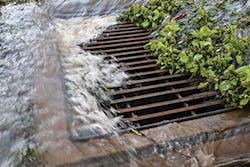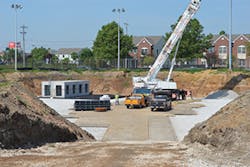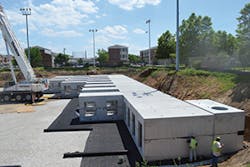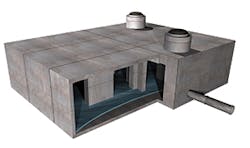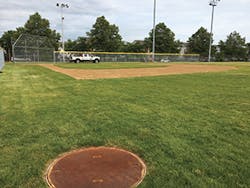In recent years, the focus on stormwater mitigation in Surfside Beach, SC, has been on water quality, notes John Adair, public works director.
“The topography along the coast is very flat, so getting the water to go toward the ocean is always a challenge because you might only have very slight variations from block to block in elevation,” he says. But a second challenge comes “under our NPDES permit in maintaining that water quality that we look for to discharge clean water into the ocean. We’re always trying to find the best ways to handle that.”
In the past, the mindset was to move stormwater out as fast as possible in concrete pipes or ditches—whatever means necessary—and get it into the nearest pond and out to the ocean without much thought for water quality, he says.
“In recent years, we’ve taken advantage of the good soils here by the beach. We have a lot of Class A and B soils, which infiltrate very well, so we’ve been using a lot of infiltration pipe and deep sump catch basins,” he says.
Surfside Beach also uses the SNOUT from Best Management Products, a vented catch basin hood or trap that captures gross pollutants such as floatables and trash as well as free oils and sediment. The town also uses the Bio-Skirt, designed to capture and retain hydrocarbons. It is treated with an anti-microbial to inhibit bacteria growth on the boom and prolong its service life.
“We’ve implemented the use of the SNOUTs to keep sediments out of the pipe, but we’ve also gotten a little innovative in using them as weirs within the system to hold water back,” says Adair. “You can put the SNOUT upside down at the tail end of a pipe—the effluent side—and a large catch basin, and it can hold back some water, so it has more of a chance to infiltrate before it goes down to the next segment of pipe.”
The town’s approach also uses deep sump catch basins and infiltration pipe. “That and a lot of other BMPs we’re doing in town have really made a good impact on our water quality,” says Adair. Testing has shown that water quality is the best it’s been in 10 years.
Adair points out that although no single BMP is a “magic bullet,” they are tools that, in combination, contribute to clean water, along with other approaches including public education, promoting the use of dog waste disposal bags, and street sweeping.
Surfside Beach belongs to a consortium of neighboring municipalities that use public service ads, billboards, and posters on solid waste trucks and street sweepers to promote the idea of “clean streets, clean beaches,” notes Adair. “We’re trying to make that connection in people’s minds that everything goes to the ocean.”
Saving the Trees
A new residential development in La Verne, CA, presented some spatial challenges for managing stormwater. Joy Hendricks, project engineer for C&V Consulting, explains that the site for the City Ventures La Verne Emerald project consisted of undeveloped, pervious land with several mature oak trees. Some of the trees would remain in place, and others were to be moved to other site locations, but all the trees had to be protected during construction.
That presented a challenge for placement of proposed drainage facilities, including an underground 48-inch detention pipe, sump catch basins, an area drain system, and other utilities.
The developer chose to install Modular Wetlands biofiltration system (MWS Linear) units from Bio Clean Environmental. Designed to function like wetlands, MWS Linear uses horizontal flow to improve performance, reduce footprint, and minimize maintenance. It is designed with a greater filter surface area, a pre-treatment chamber, and pre-filter cartridges to remove sediment and hydrocarbons from runoff before it enters the biofiltration chamber. The units are installed inline and are designed to support almost any plant life.
Instead of using multiple MWS Linear units at each sump area, Bio Clean Environmental’s DVERT system was used, enabling the collection and conveyance of low flows to one primary unit. With DVERT low-flow diversion, the diversion trough can be installed in existing or new curb and grate inlets to send the first flush of runoff to the MWS Linear. It works similarly to a rain gutter and is installed just below the opening of the inlet, capturing the low flows and channeling them to a connecting pipe exiting out the wall of the inlet and leading to the MWS Linear. The DVERT can be used in retrofit and green street applications, allowing the MWS Linear to be installed anywhere space is available.
C&V Consulting and Bio Clean Environmental collaborated to develop a Modular Wetlands System (MWS-L-8-16) vault to meet the required water-quality treatment flow rate for the whole site. The vault could accommodate the connection of three DVERT systems and the area drain system while meeting downstream storm drain depth restrictions.
“The Modular Wetlands Systems have the flexibility to be located anywhere onsite and can be easily incorporated into the landscape design,” notes Hendricks. “Most importantly from an engineering perspective, the MWS provides the ability for area drain connections and diversion of low flows, ensuring the entire site meets the governing agency’s water-quality regulations.”
The MWS Linear has been approved in the Washington State Technology Assessment Protocol – Ecology (TAPE) program and by the Rhode Island Department of Environmental Management, the Virginia Department of Environmental Quality, and the University of Massachusetts at Amherst Water Resources Research Center.
Washington granted General Use Level Designation for basic (total suspended solids [TSS]), enhanced (heavy metals such as zinc and copper), and total phosphorus treatment regiments.
The Virginia DEQ assigned the MWS Linear the highest phosphorus removal rating for manufactured treatment devices to meet the new Virginia Stormwater Management Program Technical Criteria.
The MWS Linear’s 4-foot standard planter width enables it to be used in parking lot islands and medians. In streets, its small footprint works around existing utilities on retrofit projects. It can be installed as a raised planter to treat runoff from rooftops or patios. It is sometimes used to help industrial sites meet EPA-mandated effluent limits for dissolved metals and other pollutants.
The MWS Linear can be used in decentralized LID designs and end-of-the-line configurations in low- to high-density residential developments. On commercial sites, the MWS Linear is used to meet treatment and volume control requirements in a smaller footprint. The system has available “pipe-in” options on most models along with built-in curb or grated inlets to integrate into a storm drain design.
The curb type configuration accepts sheet flow through a curb opening in roadway and parking lot applications. The grate type has a grated or drop inlet above the system’s pre-treatment chamber. It enables pedestrian access over the inlet. ADA-compliant grates are available. This configuration is also used in scenarios where runoff needs to be intercepted on both sides of landscape islands.
Pre-treatment starts with separation of trash, sediment, and debris before entry into the pre-filter cartridges. The pre-filter cartridges have more than 25 square feet of surface area. They utilize BioMediaGREEN filter material and remove more than 80% of TSS and 90% of hydrocarbons. The filter material prevents pollutants that cause clogging from migrating to the biofiltration chamber. The horizontal flow is designed for less clogging than downward flow biofilters.
The MWS Linear system has two orientations: side-by-side and end-to-end. The side-by-side orientation places the pretreatment and discharge chambers adjacent to one another with the biofiltration chamber running parallel on either side to minimize the system length and provide a compact footprint. This application is used in situations such as streets with directly adjacent sidewalks, as half of the system can be placed under the sidewalk. This orientation also offers internal bypass options.
The end-to-end orientation places the pre-treatment and discharge chambers on opposite ends of the biofiltration chamber to minimize the width of the system to 5 feet and is typically used in linear projects and street retrofits where existing utilities and sidewalks limit the amount of space available for installation. The bypass must be external with this orientation.
A wide range of plants are suitable for use in the MWS Linear with selections based on location and climate. The plants add aesthetic value as well as pollutant removal.
The system maintenance requirements are limited to the pre-treatment chamber, which can be cleaned by hand or with a standard vacuum truck. The system also requires periodic replacement of the media in the pre-filter cartridges for long-term operation.
Flooding in Philadelphia
Aging infrastructure in Philadelphia’s Grays Ferry area was unequipped to handle excessive amounts of stormwater during heavy rain events, causing the drainage system to become overloaded and flooding neighborhood streets.
The historic neighborhood is close to an important river crossing. In the 18th century, Grays Ferry was the southernmost of three ferries crossing the Schuylkill River to Philadelphia. Today, the Grays Ferry Bridge and several other rail lines span the Schuylkill River.
The neighborhood was once the site of the Schuylkill Arsenal, constructed in 1800 to provide the US military with critical supplies. The arsenal—the third federal facility in the nation—was the site of clothing and flag manufacturing for the military. Its most famous task was outfitting the expedition of Lewis and Clark.
The Philadelphia Water Department (PWD) hired the consulting engineering firm of Hatch Mott MacDonald to find a solution to the flooding. The firm recommended building a detention system to collect stormwater runoff from the streets and then allow for a controlled release to the surrounding storm drainage system. The detention system, which had to meet the treatable flow rates as well as local regulatory requirements, was placed inside a city park beneath a baseball field.
The system uses the StormCapture system from Oldcastle Precast. StormCapture’s modular system is designed to meet stormwater management needs including detention, retention, infiltration, treatment, and harvesting. Modules measure 8 feet wide by 16 feet long and can also be constructed in customized heights. The system beneath the park consists of 141 StormCapture modules and 81 LinkSlabs, which reduced the number of modules needed as well as the overall project cost. The system is able to detain 217,978 cubic feet, or 1,630,589 gallons, of stormwater runoff.
Two additional modules on the project allowed the placement of access manholes outside of the baseball playing field. The modules were offloaded from the trucks and installed by crane.
Michael Creeden, territory manager for Oldcastle’s Mid-Atlantic and Northeast regions, notes the project exemplifies the direction of stormwater management in urban areas. “The city of Philadelphia saw an opportunity to eliminate a flooding problem while maintaining the city’s green space,” he points out. “In the end, no one would ever know that we can store over a million gallons of water just inside of the park, right below the baseball field.”
Completed StormCapture installation
A School for Stormwater
At a high school in Quakertown, PA, stormwater treatment was needed that would meet water-quality regulations and be able to function in limited space.
“They needed to use some type of treatment device in order to provide the necessary removal rates and flow rates as governed by Pennsylvania’s Department of Environmental Protection design manual and different regulatory items,” says Justin Nace, stormwater product specialist with Stormwater Solution Source (S3), a Suntree Technologies representative in the Northeast area.
The solution came from Suntree Technologies’ Nutrient Removing Filtration System (NRFS) in conjunction with Bold & Gold, a biosorption activated media for nutrient removal. NRFS is a denitrifying treatment vault designed to remove solids and dissolved contaminants. It accommodates high flow rates without clogging. It provides post-detention removal of phosphorus and nitrogen.
Bold & Gold was developed by the University of Central Florida to remove TSS, phosphorous, and nitrogen. It is designed to resist clogging and has no organics to degrade.
Nace worked with design engineers to get the products specified and oversee construction by Skepton Construction in July 2017. “It’s as simple as setting up the base, dropping it down in the hole, dropping the structure in, and tying in new or existing conveyance lines,” he says.
Nace says the only challenge with the project was adjusting the installation date against a weather event. “The whole site got rained out the day before delivery,” he says. “They weren’t able to dig a hole—there was so much water on site. It delayed the delivery of the vault by a day and a half for them to get it installed on a day when it was drier.”
During construction, a bypass pipe was used and then removed after construction when the unit was installed and functioning.
“They didn’t want sediments from the site during construction going to the structure,” notes Nace.
Pest Control
Mosquitos are becoming a significant problem throughout the US, especially in warmer areas and places with standing water, notes Terry Flury, stormwater sales manager for United Storm Water. Mosquito abatement is at the center of many stormwater mitigation projects, which include United Storm Water’s connector pipe screen (CPS).
The CPS—a stainless steel device with 5-millimeter-diameter holes and an overflow system inside—is constructed to fit down into a storm drain catch basin over the outlet pipe.
“When stormwater runoff comes down the curb, it ends up in the catch basin. The connector pipe screen prevents the trash from getting into the outlet pipe or the storm drain lateral,” says Flury.
“The only way that water is going to be able to get into that lateral is during a large storm, and there is an overflow area. The connector pipe screen has a removable front screen so that it’s easy for maintenance people in the case of an emergency to pull that front cover out from the street and let everything in the pipe so there is no street flooding.”
The top deflector that fits over the top of the connector pipe screen has a hinged lid so when a mosquito vector crew conducts testing, they can reach down with a tool, lift up the top cover, and insert their test kit inside the pipe area, says Flury.
According to California state regulations, catch basins must be covered with 100% full-capture devices such as the CPS, he says. “However, there are a lot of counties that are now requiring mosquito abatement systems, whether they be CPS or other devices—something that makes it easy to be able to go in and test.”
Alameda County’s mosquito vector team wanted the device so workers don’t have to remove heavy grates to get their test kits down into the catch basin, Flury says.
Joseph Huston, field operations supervisor for Alameda County Mosquito Abatement District, points out that the idea of stormwater trash capture devices “was built around capturing trash, and nothing was taken into consideration for mosquito abatement practices. Pretty much every district throughout the state has catch basins that hold water and breed mosquitos significantly.”
The Alameda County Mosquito Abatement District has vetted a number of devices to identify those that are effective for trash capture as well as allowing testing to take place. United Storm Water’s CPS is among them.
Flury says that in situations where a CPS is used at a curb inlet basin, “we recommend that an automatic retractable screen [ARS] go in front of the curb-opening device. Whenever you put a CPS down in the catch basin, you’re catching a lot more trash because it’s not going into the outlet pipes, so with the ARS device in front of the curb opening, it keeps all of the big trash and debris from going in and eliminates a lot of maintenance for the cities.”
Testing in Hawaii, Development in California
In mid-December, Denis Friezner, director of engineering and founder of Hydra TMDL, installed the Hydra Automatic Retractable Screen (ARS) into four catch basins in Honolulu, HI. The installation was part of testing and certification for the City and County of Honolulu so that the device can be used in the Waikiki area.
“We also will install them in four more locations for AECON for evaluation. AECON provides engineering services for the state of Hawaii,” he notes.
Friezner designed the Surf Gate ARS for American Stormwater for Phase 1 of the Trash TMDL compliance the City of Los Angeles had to implement in 2004 and 2005. That ARS system had a mechanism to open or unlock when the water level reached 50% of the curb height.
The city of Santa Barbara, CA, used a Surf Gate without a locking system in a project resulting from the city’s Creeks Division receiving a $1.6 million Clean Water State Revolving Fund Grant through the American Recovery and Reinvestment Act of 2009. The underlying goals were to improve water quality and increase community awareness about water pollution by addressing pollutants of concern, removing trash and debris that could be transferred from the streets’ storm drain catch basin inlets to the storm drains and creeks.
The catch basin inlet screen design—which requires minimal maintenance—was developed over several years through a series of pilot studies with input from engineers and stormwater staff as well as the city’s Creeks Advisory Committee, elected officials, and other community members.
The project consisted of installing stainless steel retractable screens at each catch basin opening on the curb face between the street gutters and sidewalks to prevent trash from entering the storm drains, creeks, estuaries, and ocean.
Two different forms of data were collected before and after project construction to evaluate the effectiveness of the project in reducing trash, including creek trash surveys and catch basin box trash surveys.
Monitoring has revealed a reduction in trash in the catch basins and in the creeks since the screens’ installation. The city continues to maintain the storm drain screens.
“It was just a free-hanging 10-gauge (0.135-inch) perforated stainless steel panel,” notes Friezner. “This ARS just hung there by its dead weight.”
In a subsequent design of the Hydra ARS, Friezner utilizes multiple panels, or blades, with a stainless steel cable that is spring-loaded to return the blade to its home position.
“If a branch or twig gets stuck in the Hydra ARS, it only affects one or two of the Hydra blades, where the rest of the ARS still is preventing the trash from entering the storm drain,” he says. “All other stainless steel ARS systems, including the original Surf Gate, will have that one panel stay open when a branch is stuck in there; now trash can enter the storm drain until street maintenance cleans it out.”
